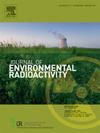Parameter uncertainty analysis of the committed equivalent dose coefficients from inhalation of radon progeny in underground uranium mines
IF 2.1
3区 环境科学与生态学
Q3 ENVIRONMENTAL SCIENCES
引用次数: 0
Abstract
This study evaluates the uncertainties in committed equivalent dose coefficients from inhalation of radon progeny in underground uranium mines. The work focuses on two exposure scenarios: wet drilling with good ventilation (Job 1) and dry drilling with poor ventilation (Job 4). The use of Monte Carlo simulations informed by the International Commission on Radiological Protection (ICRP) latest biokinetic models and parameter probability distributions obtained from published literature, revealed that Job 4 conditions yield higher lung dose coefficients than Job 1, despite both scenarios exhibiting similar uncertainty levels. The committed equivalent lung dose coefficients followed lognormal distributions, with geometric means of 61.87 mSv/(mJh/m3) and geometric standard deviation of 1.56 for Job 4 and 47.05 mSv/(mJh/m3) and geometric standard deviation of 1.58 for Job 1. The alveolar-interstitial region showed the greatest uncertainty, while the bronchial secretory cells received the highest doses. Among systemic organs, the kidneys received the largest dose. Statistical tests confirmed significant differences between the two job types. Sensitivity analysis identified tidal volume as main contributor to committed equivalent lung dose coefficient uncertainty. These findings support revising model parameters and improving breathing parameter measurements to enhance dose accuracy. The study emphasizes the necessity for enhanced ventilation, stricter air quality standards, and advanced personal protective equipment to mitigate health risks in radon-prone mining environments.
地下铀矿氡子体吸入承诺当量剂量系数的参数不确定度分析
本文对地下铀矿氡子体吸入的承诺当量剂量系数的不确定性进行了评价。工作重点是两种暴露场景:通风良好的湿式钻井(作业1)和通风不良的干式钻井(作业4)。根据国际放射防护委员会(ICRP)最新的生物动力学模型和从已发表文献中获得的参数概率分布,使用蒙特卡罗模拟表明,尽管两种情况表现出相似的不确定性水平,但Job 4条件产生的肺剂量系数高于Job 1。肺等效剂量系数服从对数正态分布,工作4的几何均值为61.87 mSv/(mJh/m3),几何标准差为1.56,工作1的几何标准差为47.05 mSv/(mJh/m3),几何标准差为1.58。肺泡间质区不确定性最大,支气管分泌细胞剂量最高。在全身器官中,肾脏接受的剂量最大。统计测试证实了两种工作类型之间的显著差异。敏感性分析发现,潮气量是承诺当量肺剂量系数不确定性的主要影响因素。这些发现支持修正模型参数和改进呼吸参数测量以提高剂量准确性。该研究强调了加强通风、更严格的空气质量标准和先进的个人防护设备的必要性,以减轻易受氡影响的采矿环境中的健康风险。
本文章由计算机程序翻译,如有差异,请以英文原文为准。
求助全文
约1分钟内获得全文
求助全文
来源期刊

Journal of environmental radioactivity
环境科学-环境科学
CiteScore
4.70
自引率
13.00%
发文量
209
审稿时长
73 days
期刊介绍:
The Journal of Environmental Radioactivity provides a coherent international forum for publication of original research or review papers on any aspect of the occurrence of radioactivity in natural systems.
Relevant subject areas range from applications of environmental radionuclides as mechanistic or timescale tracers of natural processes to assessments of the radioecological or radiological effects of ambient radioactivity. Papers deal with naturally occurring nuclides or with those created and released by man through nuclear weapons manufacture and testing, energy production, fuel-cycle technology, etc. Reports on radioactivity in the oceans, sediments, rivers, lakes, groundwaters, soils, atmosphere and all divisions of the biosphere are welcomed, but these should not simply be of a monitoring nature unless the data are particularly innovative.
 求助内容:
求助内容: 应助结果提醒方式:
应助结果提醒方式:


